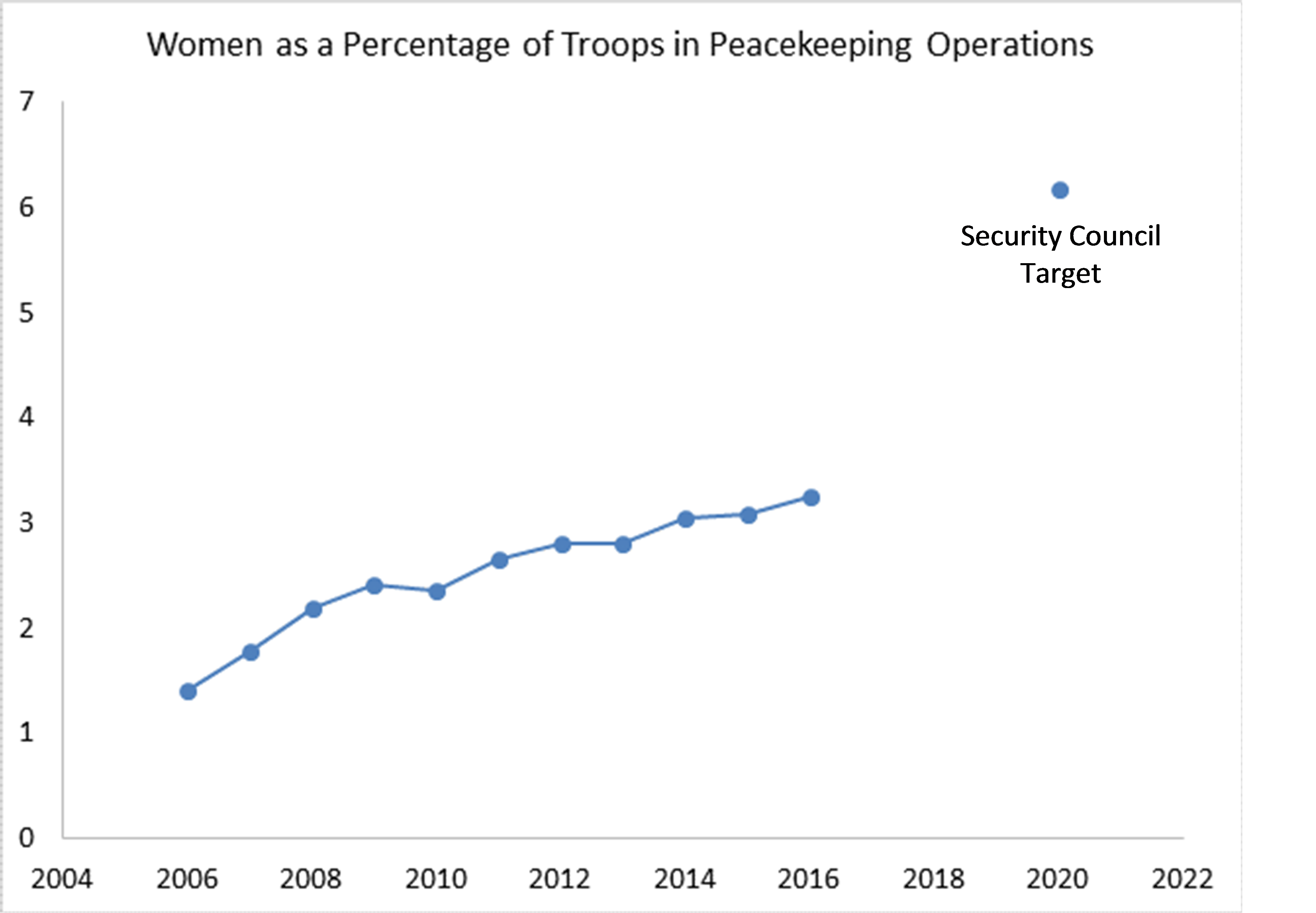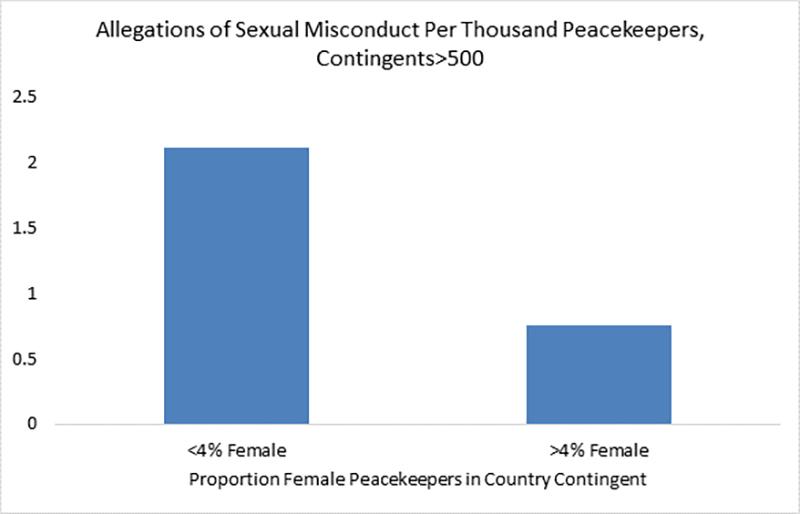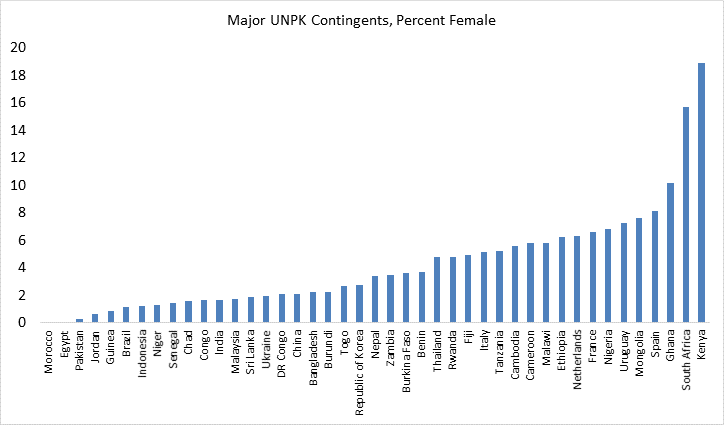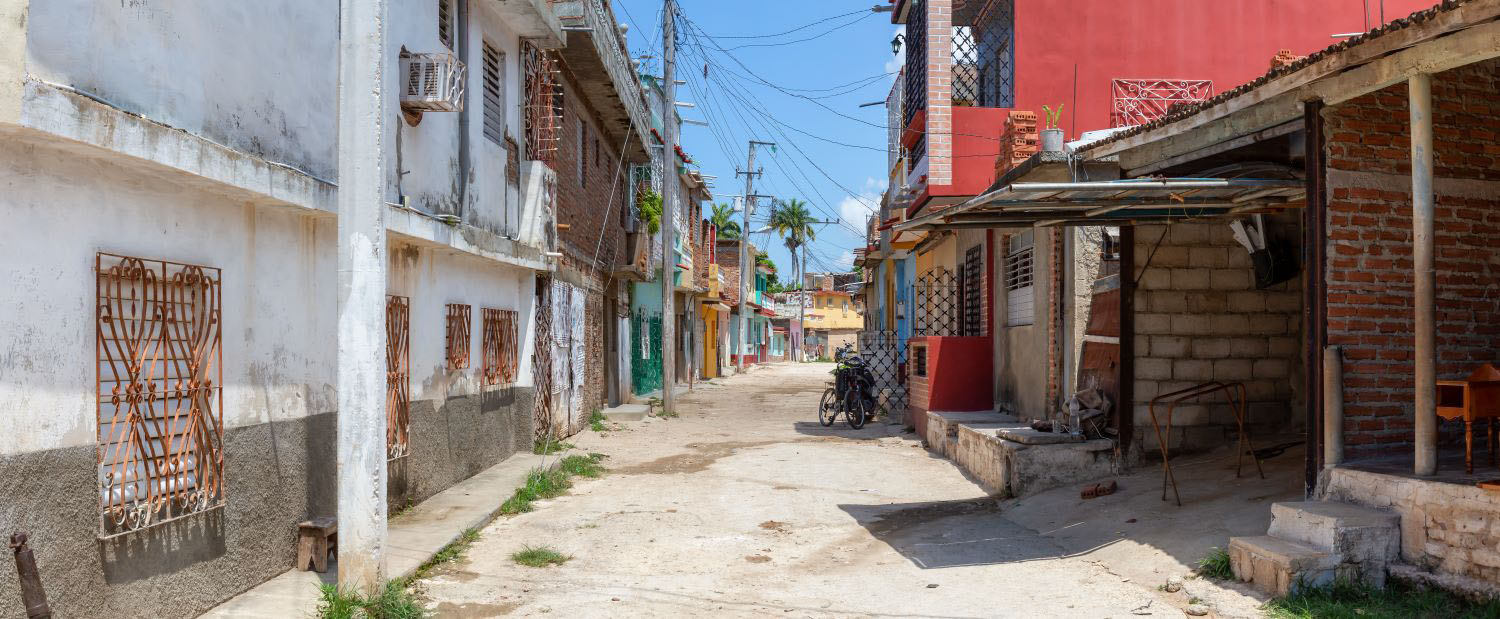Summary
At present rates of progress, it will take more than three centuries for the UN to see the same number of women as men in peacekeeping operations, even though evidence suggests that increasing the proportion of women in operations will improve the success rate of peacekeeping missions and reduce levels of sexual misconduct. One method to speed up the march to equality could be financial incentives directed at troop contributing countries. These could significantly increase the proportion of women peacekeepers, potentially for as little as $77 million per year.
Introduction
UN peacekeeping operations are a vital part of the international security architecture, helping to preserve peace and security in 16 different missions around the world. Their record is far from spotless, however – not least involving failure to prevent gender-based violence and widespread allegations of sexual abuse by peacekeepers themselves. In part because of these issues, in 2006 the UN set the target of doubling the number of female uniformed peacekeepers every year “for the next few years” and a goal for 10 per cent female representation in military contingents.[1]
In 2009, Secretary General Ban Ki-moon (re-)launched a campaign to increase the share of female peacekeepers to ten percent in military units and twenty percent in police units by 2014 (Karim and Beardsley 2013). This effort, which primarily involved exhortation, has failed. Of the 106,286 military and police peacekeepers active in July 2015, 4 percent were women. In 1993, women made up 1 percent of deployed uniformed personnel. Given progress to 2015, a linear trend would suggest that it could take 337 years to reach gender parity in peacekeeping deployments.[2]
UN Security Council Resolution 2242 (2015) recently set another target on women in peacekeeping. It “welcomes efforts to incentivize greater numbers of women in militaries and police deployed to United Nations peacekeeping operations, and calls upon the Secretary General to initiate, in collaboration with Member States, a revised strategy, within existing resources, to double the numbers of women in military and police contingents of UN peacekeeping operations over the next five years.”[3] Figure 1, below, shows the percentage of UN peacekeeping troops who were women over the period 2006-16 and the implied target for 2020 (it excludes police involved in peacekeeping operations). As the figure suggests, a dramatic uptick in the rate of progress on this indicator will be required to meet the goal – let alone the ten percent goal set by Ban Ki-moon for 2014.
Figure 1[4]

This note provides some answers to the following questions: why do we want women peacekeepers? What is behind the failure to increase women’s presence in peacekeeping operations? And how do we encourage countries to increase their contributions of women peacekeepers?
Why Do We Want More Women Peacekeepers?
There are a number of advantages to greater gender balance in peacekeeping operations. First, greater participation may help shift norms about women serving in operations in participating contingent forces, with knock-on economic and security benefits. While UN peacekeeping operations occupy only a percentage point or so of global armed forces, they could help promote the norm that women can play an active role in the military, including in operations. This should help increase acceptance of, and demand for, women in the military and help create significant formal sector employment opportunities. Women tend to make up less than one in ten of armed forces personnel in developing countries, while armed forces personnel make up approximately eight percent of non-agricultural formal sector employment in low income countries.[5]
Second, women peacekeepers have unique access to women in host countries, particularly in gender-segregated societies. This has benefits from an intelligence-gathering perspective and in assisting particular demographics in conflict-affected contexts – including survivors of gender-based violence and those at risk of being trafficked (Karim and Beardsley 2013). Perhaps as a result, there is some evidence that missions with more women personnel are more likely to meet their mandate and bring sustainable peace (Strickland and Duvvury, 2003), although this may be associated with the types of missions where women personnel are more likely to be sent.
In particular, a greater presence of women in peacekeeping operations appears to be associated with lower rates of sexual misconduct by peacekeepers themselves. This is a significant issue for UN operations: a representative survey of women aged 18 to 30 in Monrovia, Liberia, suggested that over one fourth of respondents reported transactional sex with a peacekeeper (Karim and Beardsley, 2016). And there have been 106 formal allegations of sexual misconduct reported to the United Nations with regard to peacekeepers of particular country contingents in the eighteen-month period beginning in January 2015. This is almost exactly one allegation per thousand peacekeepers over that period.
Looking at countries that contributed more than 500 personnel to peacekeeping operations in July 2015, the number of allegations of sexual misconduct per 1,000 peacekeepers over 2015 and the first half of 2016 was higher amongst contingents with low female participation. Amongst contingents with fewer than 4 percent female participants, there was an average of 2.1 allegations per 1,000 peacekeepers compared to 0.8 allegations per 1,000 peacekeepers amongst contingents with more than 4 percent female participants (see Fig. 2, below). Note that this difference is not statistically significant, and there are examples of countries with high female participation and a high level of allegations: 16 percent of South African peacekeeping forces are women, but saw 4.1 allegations per thousand peacekeepers.
Figure 2[6]

Similarly, Karim and Beardsley (2016) find that peacekeeping operations that have a higher proportion of both female peacekeepers and personnel from countries with better records of gender equality in the labor force, education and the legal system see lower levels of allegations regarding sexual exploitation and abuse (see Crawford et. al., 2014 for a similar finding). They suggest that an increase in the proportion of women from zero to five percent reduces the expected count of allegations by one half.
As with the above analysis, the authors note their results are statistically weak and “the evidence calls for further caution against strategies that highly emphasize improvements of the representation of women in security forces as a vehicle to mitigate… allegations.” Furthermore, interviews and surveys of peacekeepers suggest that only a few of the women assigned carry out duties off base, with the majority assigned to medical care, administration, translation and cooking duties (Donadio and Rial, 2015). Increasing women’s representation in peacekeeping forces should be one part of a broader response to the gender disparities and associated violations that arise in peacekeeping operations. That response should also include efforts to ensure greater representation of women in senior leadership of peacekeeping operations; more extensive training on issues of gender-based violence; and mechanisms to provide for reporting, investigation and response to allegations of sexual misconduct involving peacekeepers as both perpetrator and victim that are outside the country contingent chain of command.
There is considerably more to reducing sexual misconduct, changing other outcomes regarding interaction with host country citizens or changing norms around women in the military than simply increasing the proportion of women peacekeepers, then – but nonetheless it may help.
What is Behind the Failure to Increase the Number of Women Peacekeepers?
Amongst countries that contribute peacekeepers, the proportion sent that are women varies considerably. None of Morocco’s 2,317 peacekeepers in July 2015 were women, for example, compared to 179 out of Kenya’s 947 strong peacekeeping contingent – a 19 percent share (Figure 3 below).
Figure 3[7]

In part, this reflects the underlying structure of contributing countries’ armed forces – there is a considerable variation in the proportion of armed forces that are women around the world. In countries including Bangladesh, the proportion is below one percent whereas in a number of developed and developing countries it is between ten and twenty percent (Table 1).
But frequently the proportion of women in the military component of peacekeeping missions is lower (even) than their representation in national armed forces. Across eleven contingents supplied by NATO members to UN peacekeeping operations in 2012, nine saw lower female participation than the proportion of women in the armed forces (Carreiras, 2015). Table 1, which includes some of those countries but also a number from outside NATO suggests that the proportion of women peacekeepers in 2015 contingents is lower than dated estimates of women as a percentage of all military forces in those countries in 12 out of 21 contributor countries. This suggests the reason for a low share of women in peacekeeping operations is not simply a lack of women to send.
It appears that mission features are better able to explain the presence or absence of women in peacekeeping than sending-country military demographics. Karim and Beardsley (2013) find that countries with more gender-balanced domestic armed forces are more likely to provide women peacekeepers, but that factor is only able to explain a small part of the total variation in women peacekeepers across troop-providing countries. They suggest mission characteristics play an important part in decisions over sending women peacekeepers, with missions which have seen peacekeeper deaths and that are in low-income countries far less likely to have high female representation in peacekeeping forces. Gender balance is best, they suggest, "in environments with relatively small risk to the peacekeepers,” not where the benefits to greater female presence might be greatest – in countries that have experienced significant sexual violence, for example.
Similarly, Berg and Bjarnegard (2016) find that women troops are less likely to be present in peacekeeping operations where there have been more peacekeeper deaths and where the local level of sexual violence is higher. In peacekeeping operations which the authors consider highest risk on these dimensions, the proportion of women troops is below 0.5 percent, compared to 5.5 percent for the lowest-risk operations.
This matches earlier evidence of the limits placed on many women peacekeepers that are deployed – often being confined to base. It suggests that political and/or military leadership is unwilling to put women in harm’s way in conflict situations, this despite growing evidence both that women are effective front line troops (MacKenzie, 2012) and that a greater role for women in peacekeeping is associated with better outcomes.
How Do We Encourage Countries to Send More Female Peacekeepers?
Exhortation appears to have little impact on the proportion of women in contingents. Karim and Beardsley (2013) find that specific language in the mandates related to a peacekeeping operation discussing gender has a limited effect on the proportion of women deployed. This suggests the need for more powerful incentives. One possibility is a financial incentive.
In 2017, the United Nations will compensate troop contributors at a rate of $1,410 per month per troop plus repayment for use of equipment and weaponry of $73 and a supplementary pay for specialists of $303 (Gaibulloev et al. 2015 and UN Fifth Commission, 3 July 2014). Currently, the specialist supplement is automatically paid for a fixed proportion of a contingent.
Because of the considerable variation in costs per military personnel worldwide, this means that some countries can profit from providing soldiers while others bear a considerable financial burden. A survey carried out by the UN of ten countries that contributed peacekeepers suggested an average per person cost of $1,536, rising to $1,763 if pre-deployment medical attention, inland transportation and peacekeeping-specific training are included (Coleman, 2014). But per military person expenditures in some countries appear to be below these levels: a monthly cost as low as $158 for Nepal and ranging between $285 and $850 for Pakistan, India, Bangladesh, Ghana, Nigeria and Senegal. This contrasts notably with costs in high income countries – Canada’s per-troop expenditures are on the order of $11,421 (2009-2012 data from Gaibulloev et al. 2015).
This, potentially alongside the greater domestic political acceptability of UN troop deployment, helps to explain why poorer countries provide the bulk of UN peacekeeping forces. Bove and Elia (2011) show that countries with a lower GDP per capita are considerably more likely to supply troops to peacekeeping missions. They also show that countries with a larger military are more likely to send troops. That countries appear to respond to financial incentives to provide troops is supportive evidence that countries might respond to monetary incentives to increase female participation in peacekeeping operations.
Those who contribute peacekeepers and those who contribute financing are different groups of countries. Table 2 presents the top ten from each group and the only country to appear on both lists is China. Countries providing peacekeepers are overwhelmingly low or lower middle income; those providing finance are overwhelmingly high income. Any proposal to alter payment formulae has to appeal to both groups of countries. An additional financial incentive to provide more women peacekeepers may be such a proposal, given troop providers would gain additional finance and donors would be able to put an increased emphasis on women’s rights through their financing.
One model for a financial incentive would be to provide a percentage supplement to countries that provide women peacekeepers above the base compensation of $1,410 per month. Table 3 lays out the annual costs of such a supplement at various levels of total female share of peacekeeping forces from five to 50 percent and at supplement ranges from five to 100 percent of base compensation at 2015 levels of peacekeeper deployment (106,286 personnel). One level to set the incentive would be at $303 per month – the same rate as the specialist supplement. The last line of the table lays out annual costs of such a supplement.
Supplemental financing could be targeted at operations with characteristics that suggest they are likely to have particularly low participation by women and/or where greater participation by women might be seen as particularly valuable – operations in low income countries or countries with a worse history of sexual violence, for example. Additional financial incentives could be provided to countries which provided women officers as part of contingent forces, potentially on a sliding scale dependent on rank. And in order to ensure the greatest impact of a larger female peacekeeping contingent in operations and overall operational effectiveness, oversight would be necessary to ensure that women were not placed disproportionately in functions that were confined to base.
One model for funding the supplement would be through a small increase in assessed payments for peacekeeping. Table 4 provides data on the approximate 2017 financial contributions of the major UN peacekeeping financiers and compares it to the cost of a $303 monthly supplement for women peacekeepers assuming a 20 percent female share that has been divided up using the same formula used for overall peacekeeping budgets. Such a supplement, if financed on the same model as the basic peacekeeping budget, would add less than one percent to annual contributions. A 100 percent supplement for women peacekeepers at the same 20 percent participation level would add about 4 percent to annual contributions.
A second model for financing would involve a stand-alone trust fund financed by voluntary contributions from donors. Such a fund financed to support the $303 per month payment to women accounting for 20 percent of total peacekeeping operations would need approximately $77 million a year. This compares to overall trust fund contributions to the UN system of $846 million per year over the period 2011-2015, or $66 million per year over the same period to the United Nations Peacebuilding Fund.[8]
Again, financial incentives should be nested in a broader and expanded set of initiatives around women and security including increased training and oversight of peacekeepers. This will be especially important as the number of women in more dangerous peacekeeping operations expands, given evidence of increased risk of sexual harassment and sexual assault amongst female soldiers who are deployed (Leardman et al 2013). As part of these efforts, the UN Secretary General should use his appointment power over force commanders and police commissioners to select more women (only one has been appointed so far). In addition, the Security Council should mandate that the UN Office of Internal Oversight Services can solicit and investigate allegations of sexual exploitation in peacekeeping and give the Office authority to remove contingent members from operations if allegations are found to be credible.
Conclusion
The UN Security Council and the UN Secretary General have repeatedly called for more women to be involved in UN peacekeeping operations. They are right to do so: the available evidence suggests considerable benefits to such participation. But exhortation is inadequate. It is plausible to believe that financial incentives to provide more women peacekeepers would have an impact on the numbers deployed, and that such incentives would add only marginally to the overall cost of peacekeeping operations. Security Council member countries that are keen to see the benefits of greater women’s participation in peacekeeping operations should begin discussions with major providers of peacekeeping troops as well as major financiers of peacekeeping operations to embed supplements for women peacekeepers within the standard financing formula or create a stand-alone trust fund to provide such incentives.
Table 1: Estimates of Women as a Percentage of Armed Forces 2000-2011 compared to 2015[9]
|
|
|
|
|
|
Bangladesh |
|
|
|
|
Poland |
|
|
|
|
Switzerland |
|
|
|
|
Brazil |
|
|
|
|
Italy |
|
|
|
|
Nepal |
|
|
|
|
Philippines |
|
|
|
|
Peru |
|
|
|
|
Thailand |
|
|
|
|
Ghana |
|
|
|
|
Germany |
|
|
|
|
Spain |
|
|
|
|
Australia |
|
|
|
|
Slovenia |
|
|
|
|
United Kingdom |
|
|
|
|
US |
|
|
|
|
Canada |
|
|
|
|
France |
|
|
|
|
New Zealand |
|
|
|
|
Hungary |
|
|
|
|
South Africa |
|
|
|
Table 2: Personnel and Financial Contributors to UN Peacekeeping
|
|
|
||
|
% of total peacekeepers |
% of total funding |
||
|
Nigeria |
|
Spain |
|
|
Ghana |
|
Canada |
|
|
China |
|
Russia |
|
|
Senegal |
|
Italy |
|
|
Nepal |
|
China |
|
|
Rwanda |
|
UK |
|
|
Pakistan |
|
Germany |
|
|
India |
|
France |
|
|
Ethiopia |
|
Japan |
|
|
Bangladesh |
|
US |
|
Table 3: Costing a Supplement for Women Peacekeepers
|
|
|
||||
|
|
|
|
|
|
|
|
|
|
|
|
|
|
|
|
|
|
|
|
|
|
|
|
|
|
|
|
|
|
|
|
|
|
|
|
|
|
|
|
|
|
|
|
|
|
|
|
|
Table 4: Country Burden of a Supplement for Women Peacekeepers
|
|
|
|
|
Spain |
|
|
|
Canada |
|
|
|
Russia |
|
|
|
Italy |
|
|
|
China |
|
|
|
UK |
|
|
|
Germany |
|
|
|
France |
|
|
|
Japan |
|
|
|
US |
|
|
Endnotes
[1] http://www.un.org/en/peacekeeping/publications/yir/2006/female_peacekeepers.htm
[2] http://www.un.org/en/peacekeeping/issues/women/womeninpk.shtml
[3] http://www.securitycouncilreport.org/atf/cf/%7B65BFCF9B-6D27-4E9C-8CD3-CF6E4FF96FF9%7D/s_res_2242.pdf
[4] Sources: http://www.un.org/en/peacekeeping/resources/statistics/gender.shtml for august 2015 and 2016, Donadio and Rial (2015) for previous years, UN Security Council Resolution 2242 for target
[5] World Bank data on armed forces as a percentage of the labor force accessed from http://data.worldbank.org/indicator/MS.MIL.TOTL.TF.ZS 10/11/2016 and employment in agriculture from http://data.worldbank.org/indicator/SL.AGR.EMPL.ZS accessed 10/11/2016 Data on informal employment in non-agriculture from ILO http://laborsta.ilo.org/applv8/data/INFORMAL_ECONOMY/2012-06-Statistical%20update%20-%20v2.pdf accessed 10/11/2016. From this data, approximated that 50% of employment non-agriculture and 75% of non-agriculture jobs informal. Data on women in armed forces share from Table 1.
[6] Data sources: https://cdu.unlb.org/Statistics/DetailedOverviewofAllegationsfrom-2015onward/AllegationsAgainstUniformedonnelbyNationalitySexualExploitationandAbuse.aspx (data from 2015 onwards) and http://www.un.org/en/peacekeeping/resources/statistics/ (July 2015 data). Standard errors 1.1 for <4%, 0.3 for >4% one-tailed t-test on difference returns a p-value of 0.15
[7]Data source: http://www.un.org/en/peacekeeping/resources/statistics/
[8] Source: http://mptf.undp.org/portfolio/fund accessed 10/6/2016
[9] Source unless otherwise noted J. Mathers Women and State Military Forces in C. Cohn Women and Wars: Contested Histories, Uncertain Futures, or Carreiras, H. (2015). Women and Peace Operations. In Managing Crises, Making Peace (pp. 69-90). Palgrave Macmillan UK.2010-11 data. South Africa http://www.defenceweb.co.za/index.php?option=com_content&view=article&id=16708:fact-file-sandf-regular-force-levels-by-race-a-gender-april-30-2011-&catid=79:fact-files&Itemid=159 Australia http://www.aph.gov.au/About-Parliament/Parliamentary-Departments/Parliamentary-Library/Publications-Archive/archive/womenarmed France http://www.defense.gouv.fr/actualites/articles/femmes-de-la-defense-diaporama Switzerland ILO http://laborsta.ilo.org/ 10.zForces.zarmées 2000 Thailand ILO http://laborsta.ilo.org/ ARMED FORCES 2001 Philippines ILO http://laborsta.ilo.org/ Armed Forces Enlisted Personnel and Armed Forces Officers 2001 Estimates of Women as a Percentage of Police Officers 2009-2012 England and Wales 25.0 Eire 21.3 United States 11.8 Canada 19.6 Australian Federal Police 22.1 New Zealand 17.6 South Africa 23.5 Ghana 19.7 Nigeria 12.4 India 5.1 Fiji 20.0 Source: Prenzler, Tim and Sinclair, Georgina (2013). The status of women police officers: an international review. International Journal of Law, Crime and Justice, 41(2) pp. 115–131.
Bibliography
Berg, A., & Bjarnegård, E. (2016). Dissecting Gender Imbalance: A Horizontal Perspective on When Risk Matters for the Assignment of Women to UN Peacekeeping Missions. Res Militaris, (2).
Bove, V., & Elia, L. (2011). Supplying peace: Participation in and troop contribution to peacekeeping missions. Journal of Peace Research, 48(6), 699-714.
Carreiras, H. (2015). Women and Peace Operations. In Managing Crises, Making Peace (pp. 69-90). Palgrave Macmillan UK.
Crawford, K. F., Lebovic, J. H., & Macdonald, J. M. (2015). Explaining the variation in gender composition of personnel contributions to UN peacekeeping operations. Armed Forces & Society, 41(2), 257-281.
Gaibulloev, K., George, J., Sandler, T., & Shimizu, H. (2015). Personnel contributions to UN and non-UN peacekeeping missions A public goods approach. Journal of Peace Research, 0022343315579245.
Karim, S., & Beardsley, K. (2013). Female peacekeepers and gender balancing: token gestures or informed policymaking?. International Interactions, 39(4), 461-488.
Karim, S., & Beardsley, K. (2016). Explaining sexual exploitation and abuse in peacekeeping missions The role of female peacekeepers and gender equality in contributing countries. Journal of Peace Research, 53(1), 100-115.
LeardMann, C. A., Pietrucha, A., Magruder, K. M., Smith, B., Murdoch, M., Jacobson, I. G., ... & Millennium Cohort Study Team. (2013). Combat deployment is associated with sexual harassment or sexual assault in a large, female military cohort. Women's Health Issues, 23(4), e215-e223.
Lyytikäinen, M., Popovic, N., Penson, C. N., & Santo Domingo, A. (2007). Gender Training for Peacekeepers: Preliminary overview of United Nations peace support operations. United Nations International Research and Training Institute for the Advancement of Women (UN-INSTRAW).
MacKenzie, M. H. (2012). Let Women Fight: Ending the US Military's Female Combat Ban. Foreign Affairs, 91, 32.
Strickland, R., & Duvvury, N. (2003). Gender Equity and Peacebuilding. From Rhetoric to Reality. ICRW, Washington DC
Rights & Permissions
You may use and disseminate CGD’s publications under these conditions.





